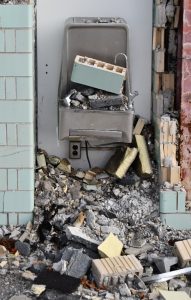 AI generated image using Adobe Firefly
AI generated image using Adobe Firefly
Whether you celebrated Festivus, Christmas or any real or recently manufactured holiday this past season, as a former upstate New Yorker my thoughts inevitably turn to snow. But sadly, after decades working in the hazardous waste arena, I admit my thoughts inevitably turn to asbestos every time someone shakes a snow globe. Over the past few years, a staggering amount of my professional time has been consumed by legacy asbestos. From managing superfund sites blanketed with the fluffy, innocuous-looking flakes to tracking ‘rip & runs’ (illegal scrapping operations, sans prior abatement), or endeavoring to stay one step ahead of a national scrapping and demolition enterprise, asbestos-related enforcement can quickly overwhelm our dockets in the northeast.
Owing to its heat resistance and fiber strength, asbestos, a naturally-occuring mineral fiber and known human carcinogen, has been mined and used since the late 1800’s in the United States. It has been used for many decades in useful consumer products such as paper products, heat-resistant textiles, and most significantly, building materials (insulation, ceiling and floor tiles, pipe wrap). While its health risks were generally known by the 1930’s, it was still used as fake snow in such Hollywood classics, as the Wizard of Oz and the holiday favorite, It’s a Wonderful Life, and even tragically in cigarette filters in the 1950’s. It wasn’t until the 1970’s that OSHA and EPA started to make inroads on reducing human exposure with OSHA establishing federal guidelines for workplace asbestos exposure and EPA banning certain asbestos-containing products. While most Americans believe that the U.S. has banned asbestos in its entirety, something that over 60 countries have already done, at this point we have only proposed banning one type of asbestos (chrysotile asbestos).

The Airing of the Grievances
In our region, my dogged civil investigator has led a multi-jurisdictional investigation into the ‘scrapping industry’ behind the creation of many of the asbestos-contaminated sites that EPA or other agencies/localities ultimately must cleanup. The industry’s modus operandi is the same – – form an out-of-state LLC to acquire a shuttered facility at auction or from a municipality at a bargain basement price and sell the local officials of an economically depressed community a redevelopment vision that will never materialize. An out-of-state scrapping company then removes anything of value from the facility (mostly metals), leaving an abandoned, asbestos-contaminated hull in their wake. The clean-up costs are often significant as is the threat to public health and the environment.
Feats of Strength – Addressing Legacy Contamination
Asbestos is both simple and complicated. The simple part is that potential products of concern are often recognizable to a generally savvy layperson and if the material is mainly intact, it can be addressed by a certified abatement contractor. The legal/regulatory landscape is where matters get more complicated with EPA regulation and enforcement authorities under TSCA, AHERA, ASHARA, CWA, CERCLA and SDWA, OSHA regulation, and state/local laws, which far exceed my word limit. However, if there has been a ‘release or a threat of release’ of friable asbestos into the environment, Superfund may be used to tackle the clean-up. However, there are limitations on EPA’s response authority under CERCLA Section 104(a)(3) if the asbestos has not been disturbed (in-place building materials), or “released” into the environment; in that case, see the CAA and Section 112 of the NESHAPs. If the asbestos problem is wholly contained inside a structure, arguably Superfund cannot respond until there is at least a credible ‘threat of release’ (which I interpret very broadly) or until the structure inevitably collapses (usually due to scrapping operations weakening the integrity of the structure); at that point the cleanup costs rise exponentially as what could have been disposed of as solid waste is now contaminated with asbestos. State laws and regulations may be of use. However, at least in New York, the regulations that give the state agency the authority to halt a flawed (or illegal) abatement effort, do not grant the agency the authority to require the cleanup of the facility at issue.
A Festivus Miracle?
How we break this ‘site creation’ pattern continues to be a focus of discussion. Education of state and local code enforcement officials, building departments, Industrial Development Agencies, and elected officials is really the key as they are the first line of defense. In the absence of an adequate asbestos abatement undertaken with proper oversight, the demolition of these facilities should never proceed. Investigation, tracking, and enforcement (civil and criminal) with press releases targeted at scrapping industry news sources will also be part of solution. We cannot wait for a Festivus miracle — prevention of Superfund sites is everyone’s job.